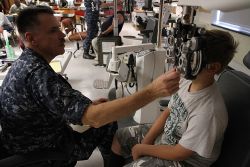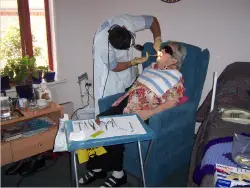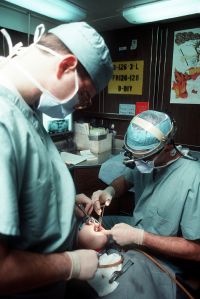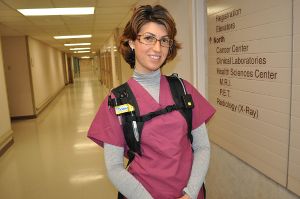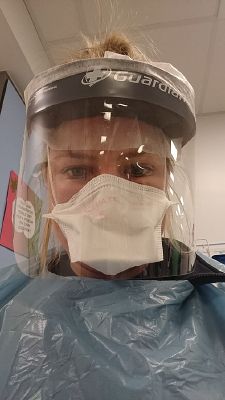Health professionals (or healthcare professionals) provide health care treatment and advice based on formal training and experience. They study, diagnose, treat, and prevent human illness and injury. The field includes those who work as a physician, surgeon, nurse, physiotherapist, dentist, midwife, psychologist, psychiatrist, or pharmacist, or who perform services in allied health professions. A health professional may also be a public health or community health practitioner.
Health care is a vital aspect of human society and a noble profession. Health care professionals in all fields are trained to serve the population as a whole while tending to each patient on an individual basis to achieve the best possible health outcome. In cases where they treat individuals with communicable diseases or experience physical and emotional stress while treating patients, health professionals do more than put the patient's well being ahead of their own, they risk their own health and safety for the sake of others.
Practitioners and professionals
The healthcare workforce comprises a wide variety of professions and occupations who provide some type of healthcare service, including such direct care practitioners as physicians, respiratory therapists, nurses, surgeons, dentists, physical and behavior therapists, as well as allied health professionals such as phlebotomists, medical laboratory scientists, dieticians, and social workers. They often work in hospitals, healthcare centers and other service delivery points, but also in academic training, research, and administration. Some provide care and treatment services for patients in private homes. Many countries have a large number of community health workers who work outside formal healthcare institutions. Managers of healthcare services, health information technicians, and other assistive personnel and support workers are also considered a vital part of health care teams.
Healthcare practitioners are commonly grouped into health professions. Within each field of expertise, practitioners are often classified according to skill level and skill specialization. “Health professionals” are highly skilled workers, in professions that usually require extensive knowledge including university-level study leading to the award of a first degree or higher qualification.[1] This category includes physicians, physician assistants, dentists, midwives, radiographers, registered nurses, pharmacists, physiotherapists, optometrists, operating department practitioners, and others. Allied health professionals, also referred to as "health associate professionals" in the International Standard Classification of Occupations, support implementation of health care, treatment and referral plans usually established by medical, nursing, respiratory care, and other health professionals, and usually require formal qualifications to practice their profession. In addition, unlicensed assistive personnel assist with providing health care services as permitted.
Healthcare practitioners may also be categorized according to the sub-field in which they practice, such as mental health care, pregnancy and childbirth care, surgical care, rehabilitation care, or public health.
Eye care practitioners
Care and treatment for the eye are delivered by ophthalmologists, medical specialists who deal with the diagnosis and treatment of eye disorders, or optometrists, health care professionals specialize in examining the eyes and applicable visual systems for defects or abnormalities as well as the correction of refractive error with glasses or contact lenses.
Foot care practitioners
Care and treatment for the foot, ankle, and lower leg may be delivered by podiatrists, chiropodists, pedorthists, foot health practitioners, podiatric medical assistants, podiatric nurses, and others.
Geriatric care practitioners
A geriatric care practitioner plans and coordinates the care of the elderly and/or disabled to promote their health, improve their quality of life, and maintain their independence for as long as possible. They include geriatricians, adult-gerontology nurse practitioners, clinical nurse specialists, geriatric clinical pharmacists, geriatric nurses, geriatric care managers, geriatric aides, Nursing aides, Caregivers, and others who focus on the physical and psychological care needs of older adults.
Maternal and newborn health practitioners
A maternal and newborn health practitioner is a health worker who deals with the care of women and their children before, during, and after pregnancy and childbirth. Such health practitioners include obstetricians, midwives, obstetrical nurses, and many others. One of the main differences between these professions is in the training and authority to provide surgical services and other life-saving interventions.[2]
Medical diagnosis providers
Medical diagnosis providers are health workers responsible for the process of determining which disease or condition explains a person's symptoms and signs. This usually involves a team of healthcare providers in various diagnostic units, including radiographers, radiologists, Sonographers, medical laboratory scientists, pathologists, and related professionals.
Mental health practitioners
A mental health practitioner is a health worker who offers services to improve the mental health of individuals or treat mental illness. They include psychiatrists, clinical psychologists, occupational therapists, clinical social workers, psychiatric-mental health nurse practitioners, marriage and family therapists, mental health counselors, as well as other health professionals and allied health professions. The most significant difference across categories of mental health practitioners is education and training.
All mental health professionals exist to improve the mental health of individuals, couples, families, and the community-at-large. These health care providers often deal with the same illnesses, disorders, conditions, and issues; however, their scope of practice often differs. Some professionals may enhance relationships while others treat specific mental disorders and illness; still others work on population-based health promotion or prevention activities.
Oral care practitioners
A dental care practitioner is a health worker who provides care and treatment to promote and restore oral health. These include dentists and dental surgeons, dental assistants, dental auxiliaries, dental hygienists, dental nurses, dental technicians, dental therapists or oral health therapists, and related professionals.
Public health practitioners
A public health practitioner focuses on improving health among individuals, families, and communities through the prevention and treatment of diseases and injuries, surveillance of cases, and promotion of healthy behaviors. This category includes community and preventive medicine specialists, public health nurses, clinical nurse specialists, dietitians, environmental health officers, paramedics, epidemiologists, health inspectors, and others.
Rehabilitation care practitioners
A rehabilitation care practitioner is a health worker who provides care and treatment which aims to enhance and restore functional ability and quality of life to those with physical impairments or disabilities. These include physiatrists, rehabilitation nurses, clinical nurse specialists, nurse practitioners, physiotherapists, orthotists, prosthetists, occupational therapists, recreational therapists, audiologists, speech and language pathologists, respiratory therapists, rehabilitation counsellors, physical rehabilitation therapists, athletic trainers, physiotherapy technicians, orthotic technicians, prosthetic technicians, personal care assistants, and others.[3]
Surgical practitioners
A surgical practitioner is a healthcare professional who specializes in the planning and delivery of a patient's perioperative care, including during the anesthetic, surgical, and recovery stages. They may include general and specialist surgeons, surgical PAs, surgeon's assistant, assistant surgeon, surgical assistant, anesthesiologists, anesthesiologist assistant, nurse anesthetists, surgical nurses, clinical officers, operating department practitioners, anesthetic technicians, perioperative nursing, surgical technologists, and others.
Alternative medicine practitioners
In addition to these recognized health care fields, practitioners of alternative medicine provide possibly healing treatments to those who seek medical help that may be outside the formal health care system. These include practitioners in acupuncture, Ayurveda, herbalism, homeopathy, naturopathy, Reiki, Siddha medicine, traditional Chinese medicine, traditional Korean medicine, Unani, and Yoga. In some countries, chiropractors (may be called osteopaths outside the United States) are considered alternative medicine practitioners.
Regulation and registration of professionals
Health professionals must satisfy certain standards in order to practice. These include licensure, certification, and proof of minimum training for regulated health professions.[4] The number of professions subject to regulation, the requisites for an individual to receive professional licensure or certification, the scope of practice that is permitted for the individual to perform, and the nature of sanctions that can be imposed for failure to comply vary across jurisdictions.
Most countries have credentialing staff in regulatory boards or health departments who document the certification or licensing of health workers and their work history. The processes for professional certification and licensure vary across professions and countries. Practicing health care without the appropriate license is generally a crime.
Medical practice requisites
Most countries require individuals to demonstrate proof of graduation from a recognized medical school, such as one meeting the quality assurance standards of the World Federation of Medical Education,[5] as requisite to obtain professional certification for practice as a physician or physician assistant.
Nursing requisites
Registered nurses and licensed practical nurses (or the equivalent national titles, such as enrolled nurses) must typically complete nursing school and pass a national examination in order to obtain their license.
The legal requisites as well as scope of practice for nurses (and also midwives and nurse midwives) vary across countries. For instance, in some countries nurses are trained and authorized to provide emergency childbirth care, including administration of oxytocins and newborn resuscitation, whereas in other countries these clinical functions are only authorized for physicians.[2]
Respiratory Therapy requisites
Respiratory Therapists or Respiratory Care Practitioners in many countries are required to have graduated from an accredited and recognized college or university and additionally pass a registry exam prior to being eligible for licensure. In the United States, Respiratory Therapists are granted either Registry or Certificate credentials by the National Board for Respiratory Care (NBRC). The credential granted by the NBRC must be maintained to continue to hold a state license to practice, and a fee must be paid every two years to the NBRC to maintain that credential.
Other professional requisites
Dentists and many other categories of allied health professions typically also require professional certification or licensure for legal practice. Training and knowledge in basic life support is required by regulation for certification for many practicing individuals, including emergency medical technicians.
Requisites and regulations for other professions, such as paramedics, clinical officers, dietitians, and homeopaths, vary across countries. They may also vary over time within countries.
Practicing without a license
Practicing without a license that is valid and current is typically illegal. In most jurisdictions, the provision of health care services is regulated by the government. Individuals found to be providing medical, nursing, or other professional services without the appropriate certification or license may face sanctions and criminal charges leading to a prison term. The number of professions subject to regulation, requisites for individuals to receive professional licensure, and nature of sanctions that can be imposed for failure to comply vary across jurisdictions.
Occupational hazards
The healthcare workforce faces unique health and safety challenges and is recognized by the National Institute for Occupational Safety and Health (NIOSH) as a priority industry sector in the National Occupational Research Agenda (NORA) to identify and provide intervention strategies regarding occupational health and safety issues.[6] Workplace stress is pervasive in the health care industry because of such factors as inadequate staffing levels, long work hours, exposure to infectious diseases and hazardous substances leading to illness or death, and in some countries threat of malpractice litigation. Other stressors include the emotional labor of caring for ill people and high patient loads. The consequences of this stress can include substance abuse, suicide, major depressive disorder, and anxiety, all of which occur at higher rates in health professionals than the general working population. Elevated levels of stress are also linked to high rates of burnout, absenteeism, diagnostic errors, and reduced rates of patient satisfaction.[7] There is some evidence that cognitive-behavioral therapy, relaxation training and therapy (including meditation and massage), and modifying schedules can reduce stress and burnout among multiple sectors of health care providers.[8]
Exposure to respiratory infectious diseases like tuberculosis (caused by Mycobacterium tuberculosis) and influenza is a significant occupational hazard for health care professionals. Healthcare workers are also at risk for diseases that are contracted through extended contact with a patient, such as scabies. Health professionals are also at risk for contracting blood-borne diseases like hepatitis B, hepatitis C, and HIV/AIDS through needle stick injuries (the penetration of the skin by a hypodermic needle or other sharp object that has been in contact with blood, tissue, or other body fluids before the exposure) or other contact with bodily fluids.[9] This risk can be mitigated with vaccination when there is a vaccine available, such as with hepatitis B.
In epidemic situations, such as the 2014-2016 West African Ebola virus epidemic, the 2003 SARS outbreak, and the COVID-19 pandemic, healthcare workers are at even greater risk, and are disproportionately affected in such outbreaks. In general, appropriate personal protective equipment (PPE) is the first-line mode of protection for healthcare workers from infectious diseases. For it to be effective against highly contagious diseases, personal protective equipment must be watertight and prevent the skin and mucous membranes from contacting infectious material. Different levels of personal protective equipment created to unique standards are used in situations where the risk of infection is different. Practices such as triple gloving and multiple respirators do not necessarily provide a higher level of protection and present a burden to the worker, who is additionally at increased risk of exposure when removing the PPE. Compliance with appropriate personal protective equipment rules may be difficult in certain situations, such as tropical environments or low-resource settings.
Female health care workers may face specific types of workplace-related health conditions and stress. According to the World Health Organization, women are prone to musculoskeletal injury (caused by physically demanding job tasks such as lifting and moving patients) and burnout. Female health workers are exposed to hazardous drugs and chemicals in the workplace which may cause adverse reproductive outcomes such as spontaneous abortion and congenital malformations.
Healthcare workers are at higher risk of on-the-job injury due to violence. Drunk, confused, and hostile patients and visitors are a continual threat to providers attempting to treat patients. Violent incidents typically occur during one-on-one care; being alone with patients increases healthcare workers' risk of assault. Workplace violence can also cause psychological trauma.[10]
Health care professionals are also likely to experience sleep deprivation due to their jobs. Many health care professionals are on a shift work schedule, and therefore experience misalignment of their work schedule and their circadian rhythm. Sleep deprivation also predisposes healthcare professionals to make mistakes that may potentially endanger a patient.[11]
Shortage of health professionals
Many jurisdictions report shortfalls in the number of trained health human resources to meet population health needs and/or service delivery targets, especially in medically under-served areas.
At the international level, in 2013 the World Health Organization reported a 7.2 million shortage of doctors, midwives, nurses, and support workers worldwide. They estimated that by 2035 there would be a shortage of almost 12.9 million, which would serious implications for the health of billions of people across all regions of the world. The report, entitled "A universal truth: No health without a workforce," identified several key causes of the shortage:
- An ageing health workforce with staff retiring or leaving for better paid jobs without being replaced, while inversely, not enough young people are entering the profession or being adequately trained.
- Increasing demands put on the sector from a growing world population with increased risks of noncommunicable diseases (for example, cancer, heart disease, stroke).
- Internal and international migration of health workers exacerbates regional imbalances.[12]
Notes
- ↑ Classifying health workers World Health Organization, Geneva. Retrieved June 17, 2020.
- ↑ 2.0 2.1 N. Gupta et al., Human resources for maternal, newborn and child health: from measurement and planning to performance for improved health outcomes Human Resources for Health 9(16) (June 24, 2011). Retrieved June 17, 2020.
- ↑ N. Gupta et al., Health-related rehabilitation services: assessing the global supply of and need for human resources BMC Health Services Research 11 (2011): 276. Retrieved June 17, 2020.
- ↑ M.R. Dal Poz, N. Gupta, E. Quain, and A.L.B. Soucat, Handbook on Monitoring and Evaluation of Human Resources for Health (Geneva, World Health Organization, 2009, ISBN 978-9241547703).
- ↑ Basic Medical Education WFME Global Standards for Quality Improvement World Federation for Medical Education. Retrieved June 17, 2020.
- ↑ National Occupational Research Agenda for Healthcare and Social Assistance CDC. Retrieved June 17, 2020.
- ↑ Exposure to Stress: Occupational Hazards in Hospitals NIOSH Publication No. 2008–136, July 2008. Retrieved June 17, 2020.
- ↑ J.H. Ruotsalainen, J.H. Verbeek, A. Mariné, and C. Serra, Preventing occupational stress in healthcare workers The Cochrane Database of Systematic Reviews 4 (April 7, 2015). Retrieved June 17, 2020.
- ↑ Thomas Cunningham and Garrett Burnett, Does your workplace culture help protect you from hepatitis? National Institute for Occupational Safety and Health Science Blog, May 17, 2013. Retrieved June 17, 2020.
- ↑ Dan Hartley and Marilyn Ridenour, Workplace Violence in the Healthcare Setting Medscape, September 13, 2011. Retrieved June 17, 2020.
- ↑ Claire C. Caruso, Running on Empty: Fatigue and Healthcare Professionals Medscape, August 2, 2012. Retrieved June 17, 2020.
- ↑ Global health workforce shortage to reach 12.9 million in coming decades World Health Organization, November 11, 2013. Retrieved June 17, 2020.
ReferencesISBN links support NWE through referral fees
- Dal Poz, M.R., N. Gupta, E. Quain, and A.L.B. Soucat. Handbook on Monitoring and Evaluation of Human Resources for Health. Geneva, World Health Organization, 2009. ISBN 978-9241547703
- Makely, Sherry, Shirley A. Badasch, and Doreen S. Chesebro. Becoming a Health Care Professional. Pearson, 2013. ISBN 978-0132843232
- Porche, Demetrius J. Health Policy: Application for Nurses and Other Health Care Professionals. Jones & Bartlett Learning, 2018. ISBN 978-1284130386
- Pozgar, George D. Legal and Ethical Issues for Health Professionals. Jones & Bartlett Learning, 2019. ISBN 978-1284144185
External links
All links retrieved June 25, 2024.
- Health workforce World Health Organization.
- Types of health care providers Medline Plus.
- Human Resources for Health
- Adapting to a Public Health Crisis
| |||||||||||||||||
Credits
New World Encyclopedia writers and editors rewrote and completed the Wikipedia article in accordance with New World Encyclopedia standards. This article abides by terms of the Creative Commons CC-by-sa 3.0 License (CC-by-sa), which may be used and disseminated with proper attribution. Credit is due under the terms of this license that can reference both the New World Encyclopedia contributors and the selfless volunteer contributors of the Wikimedia Foundation. To cite this article click here for a list of acceptable citing formats.The history of earlier contributions by wikipedians is accessible to researchers here:
The history of this article since it was imported to New World Encyclopedia:
Note: Some restrictions may apply to use of individual images which are separately licensed.

